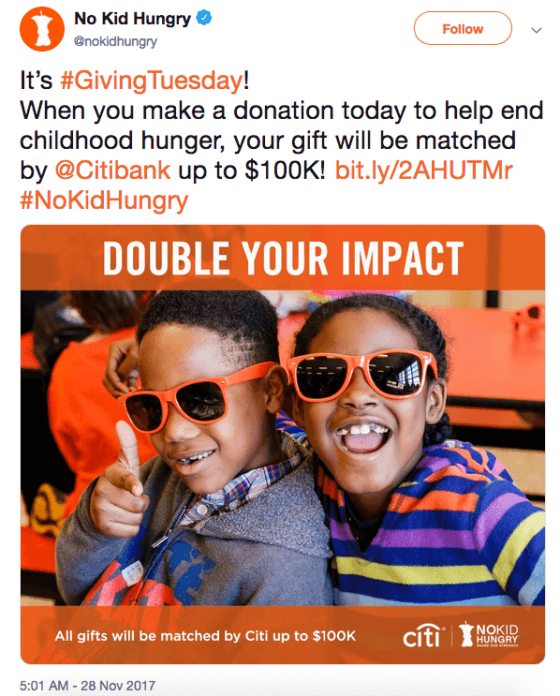In its seventh year, #GivingTuesday has become a well-established brand among nonprofits, NGOs, and ordinary citizens looking to support worthy causes. At the same time, #GivingTuesday campaigns compete for screen time with an endless flow of holiday season advertisements. So how do organizations break through the noise and implement an effective #GivingTuesday campaign?
Here’s a look at three organizations and their successful #GivingTuesday strategies.
No Kid Hungry
No Kid Hungry works to end child hunger in America by helping families access meals and nutrition education in their communities. In 2017, the organization aimed to raise $100,000 on #GivingTuesday. With a successful campaign strategy, they reached over $310,000 – more than four times their prior year’s record!
Before the campaign started, the non-profit had already created a group of online influencers who shared a commitment to addressing the problem of child hunger. Called the Social Council, this group convened throughout 2017 to brainstorm ways to help No Kid Hungry meet its #GivingTuesday goal. These efforts yielded a few compelling strategies. First, No Kids Hungry supporters created personal fundraising pages to promote the campaign and solicit funds from their networks. To assist them, the organization led energetic “how-to” webinars that shared best practices for these supporters and generated excitement for the campaign. In addition, No Kids Hungry enlisted celebrity advocates to strategically post tweets before and during #GivingTuesday. The organization also partnered with a corporate entity (Citibank) to match individual donations up to $100,000.

Children’s Miracle Network Hospitals
Children’s Miracle Network Hospitals directed a social campaign on #GivingTuesday in 2017 that encouraged authenticity – the sharing of real, everyday moments that highlight care in children’s hospitals – and used the hashtag #GoodDayBadDay. The patients at children’s hospitals around the country have good and bad days, and the objective of the campaign was to cut through the social chatter and share authentic moments in honor of kids undergoing treatment. Children’s Miracle Network thanked their many sponsors on #GivingTuesday, and worked to spread awareness and raise funds for hospitals in their network.
Why was this campaign effective? To start, the organization was genuine and authentic in sharing stories of children undergoing treatment through videos, images and quotes. These stories resonated with one of their target audiences, parents of children who have needed care or currently need care. In addition, corporate sponsors, celebrities, and supporters were all encouraged (and in some cases prepped in advance) to share their experiences using the #GoodDayBadDay hashtag. Children’s Miracle Network also hosted a Facebook Live that gave viewers an inside look into the hospital and explained in interesting and creative ways how the donations would be used. (Needless to say, the live event included a “Donate” button that enabled giving in real time.)
American Red Cross
In 2015, the American Red Cross launched a “10 Days of Giving Back” campaign leading up to #GivingTuesday. Through this 10-day countdown, the organization thanked different groups of volunteers each morning (e.g. community members advocating for fire safety, public servants trained by its CPR program, humanitarian workers delivering emergency messages to members of the U.S. military). The campaign was deliberately timed to launch ahead of Thanksgiving, in order to secure an advantage over other non-profits that flood the social conversation on #GivingTuesday itself.
A campaign budget of $0 didn’t stop the American Red Cross. They leveraged in-house resources to share compelling personal stories through its social media channels. They put their 3,000+ Social Ambassadors to work, notifying them through email to promote the “10 Days” campaign. In addition, the Red Cross reached out to corporate partners and tapped into their 61 regions across the country to ensure active participation in the campaign. All social messages connected potential givers to a well-designed donation website.
What did all three of these #GivingTuesday campaigns have in common?
All three organizations prepped their campaigns months in advance of #GivingTuesday. In addition, they did the following:
- Engaged and activated a team social ambassadors (including volunteers, celebrities, and online influencers)
- Leveraged corporate sponsorships and donation matches
- Used a campaign-specific hashtag alongside #GivingTuesday (i.e. #NoKidHungry, #GiveWithMeaning, #GoodDayBadDay) to track campaign performance
Getting a late start?
Even if your organization lacks the resources and capacity of the Red Cross, it’s not too late to organize a fruitful #GivingTuesday campaign for your non-profit. We’ve collected the following useful online resources to help you get a last-minute campaign together:
- #GivingTuesday’s complete 2018 communications toolkit
- Additional #GivingTuesday case studies from national non-profits
- 15 campaign ideas and resources from Classy.com
- E-book from DonorPerfect on how to create a #GivingTuesday campaign





